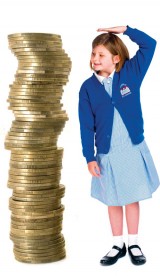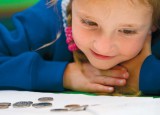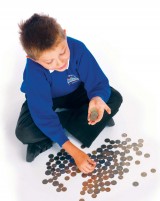Learning about money can be the basis for some engaging lessons on problem solving, suggests Mike Askew...
For younger pupils, becoming fluent in counting on in various coin values and making amounts up to £1 provides a sound foundation for being confident in calculating with money.
 Being able to fluently count on in 2s, 5s or 10s from any amount is a key skill in working effectively with money. The ‘Counting chorus’ provides a fun, whole class way of playing with these counts.
Being able to fluently count on in 2s, 5s or 10s from any amount is a key skill in working effectively with money. The ‘Counting chorus’ provides a fun, whole class way of playing with these counts.
Divide the class up into three groups. One group is counting in 2s, one in 5s, and one in 10s. Get each group to practice their count on their own.
You then ‘conduct’ this three-part chorus in counting up, switching between the groups - as a new group takes over they continue the count from the last number, but counting on their amount. For example, if the 2s have counted up to 10 and you ‘bring in’ the 5s for three beats, and then switch to the 10s for three beats, and then back to the 2s, the count will go:
2, 4, 6, 8, 10, 15, 20, 25, 35, 45, 55, 57, 59, 61
Children really have to listen to each other and become skilled in picking up the count from any number.
This activity provides a follow-up to the ‘Counting chorus’. Have a tin can with some coins in it, and a collection of coins all of the same value, say 10p. Tell the children how much is in the can to start with, say 30p. You drop coins into the can, one at a time, and the children have to count on in their heads until you stop. Does everyone agree on the final amount in the tin? Empty the coins out and get a child to come and check the amount. Varying the starting amount can make this harder – for instance having 27p in the can and dropping in 5p coins.
Making amounts up to an exact pound stands children in good stead for later work with money. This is a simple game for children to play in pairs. It is best if they have real money.
Each pair of children has a bag or box lid containing exactly £1 in coins. It may be best to start with only two types of coins in the bag, say 20p and 5p coins. (As children develop confidence with making amounts up to a pound, the combinations of coins in the bag can be changed.)
The children take it in turns to take some of the coins out of the bag and, without counting them, hide them under a piece of paper. Working together, they count the total amount of money left in the bag and then figure out how much was removed. Some children may need more coins available to help them make up the amount to a pound, but some may be able to work with paper and pencil or even mentally. When they have figured out how much was removed, children check their answer by counting up the hidden coins.
It is easy to set up simple shopping problems for children to work on, and such problems can provide a way of practising calculations with money. The ‘Tuck shop’ and ‘Would you rather?’ activities below offer suggestions for thinking about and investigating situations involving money that go beyond the usual “How much change from £1?” problems.
Prepare the following menu to display on the IWB or on sheets to give out.
| Snacks | |
|---|---|
| Crisps | 65p |
| Corn chips | 70p |
| Bag of nuts | 45p |
| Fruit | |
|---|---|
| Apple | 25p |
| Orange | 30p |
| Pear | 40p |
| Drink | |
|---|---|
| Juice | 70p |
| Mineral Water | 40p |
| Milk | 55p |
 While it is common practice to use such price lists to ask children to find the prices of various combinations – a bag of nuts, an apple and a juice, say – lists like this can also be used to introduce children to the idea of a general statement and how to investigate this by considering particular cases.
While it is common practice to use such price lists to ask children to find the prices of various combinations – a bag of nuts, an apple and a juice, say – lists like this can also be used to introduce children to the idea of a general statement and how to investigate this by considering particular cases.
For example, put up a statement like:
You need more than £1 to buy a snack and a drink.
Do the children think this is true? Can anyone find a snack and drink combination that costs less than £1? How did they find this?
You can buy a drink and piece of fruit for less than the price of a bag of crisps.
A key discussion here will be around ‘less than the price of a bag of crisps’. Children will figure out that you can buy and apple and mineral water for 65p - the price of a bag of crisps - but the statement is not true as this is not less than that price. Ask children to work in pairs to make up some statements for the class to test out.
We tend to treat teaching money as something that has to have a realistic practical application, but it can also be used as a springboard for some mathematical investigations. ‘Would you rather…?’ presents children with some playful situations that do not have an immediately obvious solution and require them to bring together different aspects of mathematics. The basic structure is to offer two things to choose between - the children make an initial choice and then do the maths to help them decide if they made the best choice.
Would you rather have:
a) Your weight in 20p coins…or
b) Your height as a stack of £1 coins
Would you rather have:
a) £1 a day, every day for a month
b) 1p on day one, 2p on day two, 4p on day three, 8p on day four and so on for a month.
Children get very creative making their own up
In upper Key Stage 2, children are expected to begin to recognise, represent and interpret simple number relationships, constructing and using formulae in words and symbols. Situations involving money provide the ideal way of introducing formulae, for example, c = 20n is the cost, in pence, of n articles at 20p each.
Spreadsheets are a powerful tool to use to help children focus on the mathematics of expressing things in such general ways, and not get bogged down in the particular calculation. ‘Party bags’ and ‘Car boot sale’ provide two contexts for exploring this.
At a shop one coloured pencil costs 15p and one eraser costs 12p. You are making up party bags of coloured pencils and erasers. You want each party bag to cost between £1 and £2. What different party bags of coloured pencils and erasers could you make up?
Before setting the children off to find some possibilities, take a few examples and establish that a bag of only pencils or only erasers is fine.
10 pencils: £1.50
8 pencil and 2 erasers: £1.44
As the children come up with several possible bags, challenge them to investigate:
What amounts between £1 and £2
CANNOT be used to buy a party bag?
If the children are familiar with spreadsheets, these can be a useful tool for listing possibilities and provide a way into discussing the idea that 15n can represent the price of n pencils and 12m the price of m erasers, so the total price is 15n + 12m (do use ‘n is the number of pencils’ rather than ‘p is for pencils’ as this can lead to confusion later on).
 Ask the children to imagine that they have a number of paperbacks and CDs to sell off at a car boot sale. Talk about why choosing what price to charge is not easy - do you ‘pile ‘em high and sell ‘em cheap’ (50p for everything in this box) or sell fewer but at a higher price (Collectors’ items: £2.50 each).
Ask the children to imagine that they have a number of paperbacks and CDs to sell off at a car boot sale. Talk about why choosing what price to charge is not easy - do you ‘pile ‘em high and sell ‘em cheap’ (50p for everything in this box) or sell fewer but at a higher price (Collectors’ items: £2.50 each).
Working in pairs, the children decide on what they will charge for a book and what price they will sell a CD at. They roll a dice to determine how many books they will sell and then again to determine how many CDs. They calculate the total takings.
Children can set up a simple spreadsheet to model what happens with different prices and different sales.
| A | B | |
| 1 | Number of books sold | 16 |
| 2 | Price per book | 0.5 |
| 3 | Number of CDs sold | 20 |
| 4 | Price per CD | 0.75 |
| 5 | Takings | 23 |
Some ‘dummy’ data has already been entered: 15 books at 50 pence each and 20 CDs at 75 pence each and the formula ‘hidden’ in B5 is =B1 * B2 + B3 * B4
Having set this up it’s easy to play with the figures. Let’s price the books at £1.50 and the CDs at £2.50 and imagine we only sold half as many.
| A | B | |
| 1 | Number of books sold | 8 |
| 2 | Price per book | 1.5 |
| 3 | Number of CDs sold | 10 |
| 4 | Price per CD | 2.5 |
| 5 | Takings | 37 |
The side effects of teaching music
Ace-Music
Boosting children’s self esteem
Ace-Classroom-Support
